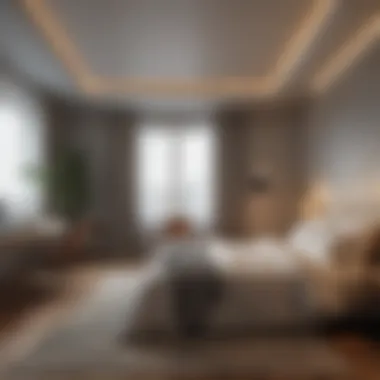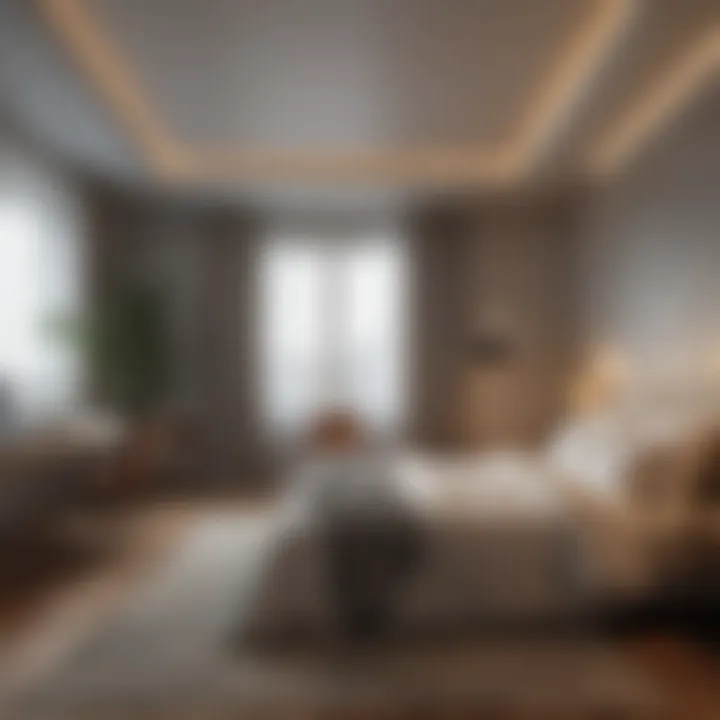Mastering Sleep: Strategies for Noisy Environments


Intro
In today’s increasingly urbanized world, achieving restfulness in noisy environments has become a pressing challenge. Noise pollution, stemming from traffic, construction, and everyday activities, can significantly impair sleep quality. Understanding the relationship between noise and sleep is crucial for optimizing restfulness. This article outlines effective strategies to combat these challenges, focusing on practical solutions and evidence-backed methods.
Research Context
Background and Rationale
Noise has long been cited as a significant disruptor of sleep. Scientific research has established a direct correlation between high noise levels and reduced sleep quality. Chronic exposure to noise leads to various physiological responses, including increased heart rate and elevated stress hormones, which can hinder the ability to fall and stay asleep. As urban densities grow, so does the need to develop strategies for sleeping amid incessant sounds.
Literature Review
Recent studies have delved into various noise management techniques. For instance, a study published in the Journal of Clinical Sleep Medicine highlights how sound masking can enhance sleep quality for individuals residing in bustling environments. Furthermore, environmental psychologists have identified that making adjustments to one’s living space can mitigate the adverse effects of noise. Research continues to evolve, shedding light on novel methods to promote sleep health despite frequent disturbances.
Methodology
Research Design
This article synthesizes findings from qualitative and quantitative research pertaining to sleep noise management. It draws on both experimental studies and observational data from diverse populations living in high-noise areas.
Data Collection Methods
The data collected includes peer-reviewed articles, sleep studies, and expert interviews. By reviewing various sources, a comprehensive understanding of effective sleep strategies amid noise was formed. Interviews with sleep specialists provided practical insights into the application of theoretical knowledge in real-world situations.
Effective Strategies
To enhance sleep quality despite noise, several strategies can be employed. These include sound masking devices, relaxation techniques, and environmental modifications. Each of these options offers unique benefits and can be tailored to individual preferences.
- Sound Masking Techniques: Utilizing white noise machines or nature sounds can reduce the perception of disruptive noises.
- Lifestyle Adjustments: Maintaining a consistent sleep schedule enhances overall sleep hygiene. Limiting caffeine and electronic device usage before bedtime can foster better restfulness.
- Behavioral Strategies: Practicing relaxation techniques like meditation or deep breathing exercises can prepare the mind for sleep, easing the transition despite external disturbances.
Research indicates that individuals who incorporate sound masking into their nighttime routines report improved sleep quality, helping to insulate the effects of surrounding noise.
By adopting these methods, individuals can create a more conducive sleep environment, improving their overall well-being and health.
Foreword
Restfulness in noisy environments is a pressing issue many face today. Understanding the significance of effective sleep strategies can have profound effects on one's overall health and productivity. This article explores practical methods to enhance sleep hygiene, even in challenging auditory conditions. By dissecting various aspects of noise's impact on sleep, we aim to provide insightful techniques and guidance that cater to a diverse readership comprised of students, researchers, educators, and professionals.
Understanding Sleep and Its Importance
Sleep is essential for physical and mental health. It promotes recovery, enhances cognitive function, and strengthens the immune system. Without adequate sleep, one may experience a decrease in focus, memory, and emotional stability. Moreover, poor sleep quality is linked to chronic issues such as obesity, diabetes, and cardiovascular disease.
Several factors contribute to sleep quality, including duration, continuity, and depth of sleep cycles. Understanding the sleep architecture, which includes different stages of sleep like REM and non-REM, is crucial for appreciating the full benefits of sleep.
The Role of Environment in Sleep Quality
The environment plays a vital role in how well we sleep. Noisy settings can disrupt our ability to fall asleep or stay asleep. Sound waves entering our sleep space may trigger stress responses and interrupt the natural progression through sleep stages. Certain environmental factors can foster improved sleep quality, while others impede it.
Several elements can affect sleep:
- Light levels: Exposure to light can interfere with melatonin production, which is essential for sleep regulation.
- Temperature: Too hot or cold conditions can make restful sleep elusive.
- Noise: Persistent or sudden noises create disturbances, affecting the overall sleep experience.
To ensure a tranquil sleep experience, it is vital to recognize these environmental factors and implement strategies that promote a conducive sleeping atmosphere.
The Impact of Noise on Sleep
Understanding the impact of noise on sleep is essential in today's fast-paced world. Many individuals face difficulties sleeping due to disturbances in their environment. Noise can come from various sources, such as vehicles, construction, or even loud neighbors. These disturbances are not just an annoyance; they actively impair sleep quality, leading to negative repercussions for health, mood, and overall well-being.
The relevance of this topic cannot be overstated. Poor sleep has been associated with numerous long-term health issues, including obesity, cardiovascular disease, and mental health disorders. Therefore, examining how different types of noise can affect sleep helps in identifying effective strategies for enhancing restfulness.
Types of Noises and Their Effects


Consistent Background Noise
Consistent background noise is often characterized by its predictability. It provides a steady sound that can mask other, more disruptive noises. This type of noise can be beneficial for promoting sleep by creating a soothing environment. Many people find it easier to fall asleep with white noise or similar sounds in the background.
One key characteristic of consistent background noise is its ability to provide a sense of security, leading to relaxation. It works by creating a sound barrier that helps the brain to filter out unexpected sounds. The unique feature is that it can be customized—such as running a fan or using a white noise machine—allowing individuals to find a sound that suits their preference. One potential disadvantage is that reliance on consistent background noise can make some individuals unable to sleep in silence, which may limit their ability to rest in different environments.
Sudden Loud Noises
Sudden loud noises include sounds like honking horns, loud music, or a dog barking. They are often disruptive and can startle individuals from their sleep. These noises can cause immediate awakening and may lead to difficulties in returning to sleep. The unpredictable nature of sudden loud noises makes them particularly damaging to sleep cycles.
A key characteristic of these noises is their abruptness, which triggers the body's stress response. This heightened level of alertness can disturb peace and contribute to insomnia over time. The unique feature is that such sudden noises can create anxiety around sleep, making an individual anticipate disturbances and feel less secure. However, one advantage is that being aware of sudden noises can encourage individuals to develop better coping mechanisms, such as soundproofing their sleeping area.
Vibrations and Resonance
Vibrations and resonance can occur due to heavy trucks passing, train vibrations, or loud music from a neighboring apartment. This type of noise may not always be audible but can still disrupt sleep through physical sensations. Notably, vibrations can interfere with sleep quality by waking individuals or causing discomfort.
These noises have a distinct characteristic—they resonate through physical surfaces. The unique aspect is that vibrations often travel through walls, floors, and other structures, circumventing traditional sound barriers. While they can create an immediate physical sensation that is hard to ignore, vibrations may also lead to a longer-lasting impact on sleep, resulting in fragmented rest.
Physiological and Psychological Responses to Noise
Stress Responses
Stress responses triggered by noise can lead to physiological consequences. When individuals perceive noise as a threat, their body may release stress hormones, such as cortisol.
The activation of this stress response highlights a key characteristic: increased heart rate and blood pressure. The body's heightened state of alertness can severely disrupt sleep quality. Ultimately, this response impacts an individual's ability to fully relax and enter restorative sleep. This has long-term implications for mental health if not addressed properly.
Disrupted Sleep Cycles
Disrupted sleep cycles are a consequence of disturbances caused by noise. Individuals who experience frequent awakenings find it difficult to maintain the necessary stages of sleep. This lack of REM sleep can affect cognitive function and emotional stability.
The primary characteristic of disrupted sleep cycles is the interruption of deep and REM sleep stages. This often results in daytime fatigue, decreased motivation, and irritability. An individual may find themselves in a constant struggle to achieve sleep longevity, reducing overall life satisfaction.
Long-term Health Effects
Long-term health effects from noise pollution are a significant concern. Continued exposure can lead to a variety of chronic health conditions, such as cardiovascular diseases, sleep disorders, and impaired cognitive function. Thinking about prevention is crucial, as noise pollution is categorized as an environmental health issue.
A critical characteristic of long-term effects is how noise exposure can accumulate, leading to persistent health problems. Since these issues may develop over years, many individuals may not connect their sleep disturbances with noise. Recognizing this connection can be vital for those seeking to improve sleep hygiene and long-term health outcomes.
Sound Masking Techniques
Sound masking refers to the strategy of using specific noises to cover up unwanted background sounds. This technique is especially relevant in achieving restful sleep amidst noisy environments. It plays a crucial role in minimizing distractions and promoting a more serene atmosphere conducive to sleep.
The benefits of sound masking include the ability to reduce perceived noise levels. By filling in the background with a more pleasant sound, the body can more easily transition into sleep. Importantly, sound masking can enhance overall sleep quality by creating an auditory environment that is less intrusive.
When considering sound masking, it is essential to choose the right source of sound. Not all noises work effectively for every individual. Some may find constant white noise to be soothing, while others may prefer nature sounds. Additionally, the volume and type of sound should be tailored to one’s preferences and sensitivities. The key objective is to create a sound landscape that comforts rather than irritates.
White Noise Machines
White noise machines are devices specifically designed to generate a consistent sound that covers other noises. These machines create a steady hum that can effectively mask environmental disturbances. The technology behind these devices often includes various sound options, ranging from pure white noise to sounds resembling rainfall or ocean waves.
Using a white noise machine might help individuals fall asleep faster and enjoy deeper sleep cycles. However, it is important to place these devices appropriately in the bedroom. Ideally, they should be positioned far enough from the bed to avoid causing a distraction but close enough to effectively diminish background noise.
Nature Sounds and Ambient Music
Nature sounds, such as rainfall, chirping birds, or ocean waves, are popular alternatives to white noise. Many find these sounds more relaxing and less harsh than continuous noise. Listening to ambient music can also be effective. Soft melodies can have a calming effect that promotes relaxation.
When utilizing nature sounds or ambient music, pay attention to the volume level. The sound should be loud enough to mask intrusive noise but soft enough to not disturb the sleep process. There are various playlists and streaming services dedicated to sleep sounds, making it easy for users to find what works best for them.
Smartphone Apps and Devices
In today’s digital age, specialized smartphone apps provide a handy solution for sound masking. Numerous apps are available that enable users to customize their auditory experience. These apps often have features that allow individuals to mix sounds, adjust volumes, and set timers for when the sounds should start and stop.
Smartphone devices can also play a significant role in sleep hygiene through alarms and reminders. Gentle wake-up sounds can complement sound masking strategies by ensuring that waking is distress-free and gradual.


Sound masking, when executed correctly, has the potential to transform a noisy environment into a sanctuary for sleep. By employing tools such as white noise machines, nature sounds, or dedicated smartphone apps, individuals can create their ideal sound landscape. Therefore, integrating sound masking into a nightly routine can significantly enhance sleep quality.
Physical Adjustments to the Sleeping Environment
Creating a conducive sleeping environment is crucial in alleviating distractions caused by noise. When one considers achieving restfulness, the role of physical adjustments cannot be overstated. Implementing specific changes within the sleeping area can help mitigate the intrusion of sound, thereby fostering a space more oriented towards quiet and relaxation. These adjustments often focus on the materials used in the environment and the layout of the space itself, which directly impacts sleep quality.
Noise-Reducing Materials
Acoustic Panels
Acoustic panels can significantly improve sound quality in a room by reducing echo and absorbing sound waves. This specific aspect makes them essential in enhancing overall sleep environments, particularly in urban settings. The primary characteristic of acoustic panels is their ability to break up sound waves, preventing them from bouncing off walls and creating noise disruptions. By cushioning sound transmission, they contribute to a quieter atmosphere, making them a beneficial choice for bedrooms in noisy areas.
A unique feature of acoustic panels is that they come in a range of designs and thicknesses, allowing homeowners to select products that fit their decor while effectively reducing noise. Their advantages include improved sleep quality and enhanced sound control, yet they may come with disadvantages, such as cost and installation complexity. Users may need to commit to some level of investment, both financially and in terms of effort, to see optimal results.
Soundproof Curtains
Soundproof curtains offer a practical solution for individuals seeking to minimize external noises in their sleeping environments. The primary aspect of soundproof curtains is their heavy, dense fabric, which effectively blocks outside noise, thus promoting tranquility. This makes them a popular choice among those living near busy streets or other disruptive sound sources.
The key characteristic of soundproof curtains lies in their ability not only to absorb sound but also to insulate against temperature fluctuations, thus providing dual benefits. They create a cozy atmosphere, which is important for restful sleep. However, it should be noted that while they are beneficial, they may not completely eliminate all sound. Homeowners should consider this limitation when deciding on their use.
Creating a Sleep-Conducive Layout
The layout of a sleeping area also plays a significant role in noise management. A sleep-conducive layout promotes relaxation and minimizes disturbances. Placing the bed away from windows can reduce exposure to outdoor noise. Additionally, considering furniture arrangement to create barriers to sound can enhance the overall sleeping experience. Elements such as rugs or soft furnishings can help absorb sound and further reduce noise levels in the sleep environment.
Stepwise consideration of these physical adjustments can help individuals better cope with the noise around them, promoting a sense of restfulness that may otherwise be hard to achieve.
Lifestyle and Behavioral Adjustments
The way individuals approach their daily routines significantly influences sleep quality, especially in noisy environments. Adopting suitable lifestyle and behavioral adjustments can lead to improved restfulness and longer duration of sleep. These changes affect both the physical and mental state of a person before bedtime.
Implementing a structured sleep routine, employing relaxation techniques, and limiting stimulants are foundational practices for better sleep hygiene. Each adjustment serves to mitigate the effects of noise and help the mind and body prepare for restful sleep. Together, these strategies are pivotal in enhancing overall sleep quality.
Establishing a Sleep Routine
A regular sleep routine helps create a reliable schedule that signals to the brain when it is time to wind down. This kind of predictability is essential in the context of persistent noise disturbances. Sticking to the same sleep and waking times can condition the body for optimal sleep opportunities.
Moreover, the routine should involve calming activities before bed. This could mean engaging in reading, light stretching, or listening to soft music, guiding thoughts away from the stressors of daily life and noise challenges.
Relaxation Techniques Before Bed
Incorporating relaxation techniques before sleep can effectively combat the impact of an unsettled environment. Individuals can select from a diverse array of options, including meditation and breathing exercises, tailored to personal preferences.
Meditation
Meditation is a practice where an individual focuses their mind, allowing thoughts to settle and creating a state of calm. It is considered a beneficial approach in managing stress and anxiety, which can often be heightened in noisy settings. A prominent characteristic of meditation is its versatility; it can be practiced anywhere, undisturbed by external disturbances. The unique aspect of meditation lies in its ability to foster mindfulness, thus encouraging a sense of presence and tranquility. Potential drawbacks can include difficulty in maintaining focus, particularly amidst distracting sounds, but its advantages often outweigh these challenges.
Breathing Exercises
Breathing exercises provide an effective method for alleviating the physical responses to stress caused by noise. By concentrating on the breath, individuals can promote relaxation and shift their focus from chaotic external stimuli. The primary characteristic of breathing exercises is their simplicity and accessibility; they require no special tools or spaces. This technique can induce a calming effect quickly. A notable feature of breathing exercises is their ability to lower heart rates and reduce anxiety, making it easier for individuals to transition into sleep. However, some may find it challenging to focus solely on their breath in a noisy environment, posing a minor limitation.
Limiting Stimulants
External factors, such as caffeine and excessive screen time, can adversely affect sleep. Limiting these stimulants is essential for fostering a peaceful evening environment.
Caffeine Intake
Caffeine is a well-known stimulant that can disrupt sleep patterns. It can keep the brain active, preventing necessary relaxation. The key characteristic of caffeine is its presence in numerous everyday beverages, including coffee and energy drinks. This omnipresence makes it a common factor in many people's routines, contributing to sleep disturbances in various contexts. One advantage of monitoring caffeine intake is the potential for better overall sleep quality when consumption is reduced, particularly in the hours before sleep.
Screen Time
Screen time refers to the duration spent looking at electronic devices. Research shows that exposure to screens before bed can interfere with the body's natural sleep cycle. The key issue with screen time lies in the blue light emitted by devices, which can hinder melatonin production and promote alertness. The unique feature of limiting screen time is found in its wide applicability, affecting many individuals in modern society. Balancing screen use effectively can result in a more conducive sleep environment, yet many struggle to disconnect in a fast-paced lifestyle.


By implementing these lifestyle and behavioral adjustments, individuals can improve their sleep hygiene, enabling them to achieve better restfulness despite the presence of noise.
Cognitive Strategies
Cognitive strategies play a crucial role in improving sleep quality in noisy environments. By utilizing cognitive techniques, individuals can enhance their ability to manage stress, minimize distractions, and ultimately achieve a state of restfulness, even in adverse auditory conditions. The mind has a powerful influence on sleep, and by reshaping thought patterns and engaging in focused mental exercises, one can create a more conducive atmosphere for sleep. This section will detail essential cognitive strategies that can be adopted, their benefits, and important considerations for effective implementation.
Cognitive Behavioral Approaches
Cognitive-behavioral approaches are widely recognized for their effectiveness in addressing sleep disturbances caused by external noise. This approach focuses on identifying negative thought patterns and replacing them with more constructive ones. By challenging irrational beliefs regarding sleep and noise, individuals can alter their perception of their environment.
- Identifying Triggers: It is essential to recognize the specific noise triggers that cause anxiety or disrupt sleep. Keeping a detailed record of disturbances can help pinpoint the sources of stress.
- Thought Reframing: Once triggers are identified, reframing thoughts can help reduce anxiety. For example, instead of saying "I can’t sleep because of the noise," one might think "I can adapt to this sound; it is just background noise."
- Setting Realistic Expectations: Understanding that complete silence may not be achievable allows individuals to adjust their expectations regarding sleep in noisy conditions. Embracing the idea that some disturbances are normal can lead to a more relaxed mindset.
The cognitive behavioral approach involves not only changing thoughts but also implementing practical techniques, such as relaxation exercises and mindfulness, to further support the sleep process.
Visualizing Peaceful Scenarios
Visualization is a powerful technique that can help counteract the disruptive effects of noise on sleep. This method involves mentally creating serene and peaceful images or scenarios. Engaging in visualization before sleep can help divert attention from external sounds and promote a state of calm.
- Guided Imagery: Using guided imagery can help individuals picture calm landscapes, such as a quiet beach or a tranquil forest. Focusing on the details of these images enhances relaxation and can drown out intrusive noises.
- Routine Practice: Regularly practicing visualization techniques can help condition the mind to shift focus away from stressors. It becomes a learned response during sleep preparation, leading to greater effectiveness over time.
- Combining Techniques: Individuals may find that combining visualization with breathing techniques creates a powerful synergy, amplifying the benefits of both strategies.
"By employing cognitive strategies, one can transform the narrative surrounding sleep and noise into a more manageable and less anxiety-inducing experience."
For more information, you can refer to reputable resources such as Wikipedia, Britannica, or forums like Reddit where people share personal experiences and tips.
Evaluating Sleep Quality
Evaluating sleep quality is a crucial aspect of understanding how effectively one can rest in noisy environments. It encompasses a range of factors that affect sleep, such as duration, depth, and the frequency of disruptions. The ability to assess sleep quality can help individuals identify patterns and areas of concern, leading to better strategies for improving their rest.
When it comes to noisy surroundings, evaluation can reveal how external factors play a significant role in disruptions. Factors such as noise intensity, duration of exposure, and individual sensitivity to sound contribute to whether a person experiences restorative sleep. By systematically evaluating sleep, one can not only pinpoint problems but also track improvements as new strategies are implemented. This consistently informs behavioral and environmental adjustments.
Using Sleep Journals
Sleep journals offer a tangible method for tracking sleep patterns over time. In a sleep journal, users record details about their nightly sleep, including time taken to fall asleep, sleep duration, perceived quality of sleep, and any disturbances experienced during the night. This exercise has several benefits:
- Enhanced Awareness: Tracking nights helps individuals recognize patterns linked to environmental noise.
- Identifying Triggers: With ongoing documentation, it becomes easier to identify specific noises that cause disturbances, allowing for the development of targeted solutions.
- Motivation for Change: Observing improvements can encourage users to maintain good sleep practices and continue refining their environment even more.
While keeping a sleep journal requires discipline, it can yield valuable insights that lead to effective adjustments and enhanced sleep quality.
Sleep Tracking Devices
Technological advancements have led to the emergence of sleep tracking devices that offer detailed insights into sleep quality. These devices, often worn on the wrist or as part of smart bedding, measure various sleep parameters, including:
- Sleep Stages: They often track time spent in light, deep, and REM sleep, providing a comprehensive picture of nightly rest.
- Environmental Factors: Many devices also measure factors like room temperature and noise levels, helping correlate them with sleep quality.
- Heart Rate: Monitoring heart rate variability can indicate how well a body is recovering during sleep.
Using a sleep tracking device serves several purposes. It can offer a quantitative evaluation of sleep, which provides an objective basis for making lifestyle changes. Furthermore, by combining the data from journals and devices, individuals can correlate subjective experiences with objective measurements. This dual approach can lead to more effective strategies for achieving restful sleep in noisy conditions.
Ending
In the face of an increasingly noisy world, achieving restfulness can seem like a formidable challenge. However, this article has outlined a comprehensive array of strategies that aim to convert less-than-ideal sleeping conditions into a more manageable experience. The core focus remains on understanding the complex interplay between noise and sleep, which influences not just rest quality but overall health and well-being.
Summary of Techniques
The techniques discussed throughout the sections can be categorized into several distinct approaches:
- Sound Masking Techniques: Options like white noise machines or ambient nature sounds can effectively drown out disruptive noises, creating a more conducive auditory environment for sleep.
- Physical Adjustments: Using noise-reducing materials such as acoustic panels or soundproof curtains can physically block unwanted sound, making a bedroom sanctuary-like.
- Lifestyle Adjustments: Establishing a consistent sleep routine and adopting relaxation techniques can prepare the mind and body for restorative rest.
- Cognitive Approaches: Engaging in cognitive behavioral strategies can help reshape one’s perception of external noise, facilitating a deeper state of relaxation despite disturbances.
To achieve an elevated sense of restfulness, it may be necessary to integrate multiple techniques tailored to individual preferences. Each aspect is critical, yet they work synergistically to promote a holistic environment for sleep.
Encouragement for Continuous Improvement
Improving sleep quality, particularly in noisy circumstances, is not a one-off endeavor. It is an ongoing process that requires commitment and adaptability. Begin with the strategies outlined in this article and observe which ones resonate with your lifestyle and sleep patterns.
Regularly assessing the effectiveness of your approach can lead to incremental enhancements in your sleep hygiene.
Consider maintaining a sleep journal where you can track improvements and identify what changes yield the most positive outcomes. Experiment with combining strategies, like sound masking with a dedicated sleep schedule, to discover a personalized solution.
To reiterate, every person’s needs vary, and finding your optimal sleep environment takes time and experimentation.
Emphasizing the importance of adapting methods helps not just in alleviating immediate noise-related disruptions, but also fortifies one’s overall resilience against environmental stressors. With dedication to these strategies, restful sleep is achievable, no matter the noise. Ultimately, persistence leads to progress.



